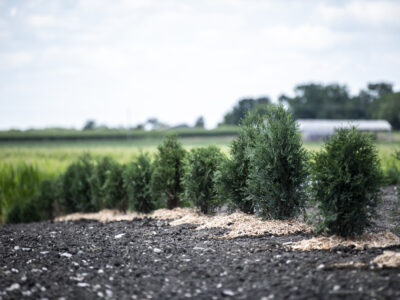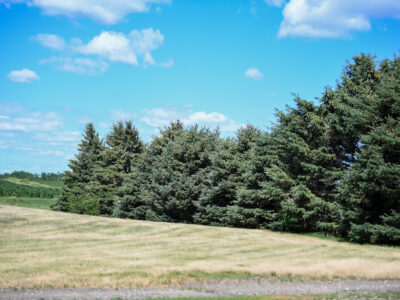Back to the Basics: Windbreaks and Tree Species Selection
05-28-2015 in Green Farmstead Partner
When it comes to planting windbreaks, tree selection is key to meeting the goals of a successful vegetative buffer. Depending on the intended purpose of the buffer, a variety of deciduous, evergreen or ornamental trees may be chosen when designing a windbreak on your farm site.
After assessing the farm and determining a timeline for planting, you may be wondering what trees are most suitable for your project. Knowing the basic differences in tree species can help you decide what trees will work best on your farm.
Deciduous Trees
Deciduous trees are easily identified by their broad, flat leaves which are seasonally shed in the fall. Because deciduous trees develop large canopies that provide shade in the spring and summer, they can assist in lowering energy costs.
Common examples of deciduous trees include maple, birch and oak. Another deciduous plant, the hybrid willow or austree, is often a popular choice for windbreaks because it grows rapidly, sometimes up to 10 feet in a year.
In the winter months, deciduous trees can have a positive impact in controlling snow. Because these trees are able to slow air flow and decrease wind speeds, an even dusting of snow will occur on the site rather than large accumulations.
Evergreens
In contrast to deciduous trees, evergreen foliage persists throughout the year and provides year-long screening. Evergreens provide snow protection and reduce wind speeds during the winter months. Some examples of evergreens include fir trees, pine and spruce.
An advantage of the evergreen includes the thick, waxy cuticle layer of the needles which protects from nutrient leaching by rainfall. Additionally, the longer leaf span of needles compared to broadleaves allows evergreens to use collected nutrients, such as nitrogen, more efficiently than deciduous plants.
While deciduous trees control snow more evenly, evergreens tend to drop or dump snow in drifts due to their greater density. For this reason they should be planted far enough from livestock barns to prevent snow from drifting on the roof or by the pit fans. Because evergreens are so dense, they should also be avoided or cautiously planted on the south and east sides of livestock facilities, especially those that are naturally ventilated.
Ornamental Trees
Adding ornamental trees to your farm site is a great way to enhance the beauty of the landscape and improve neighbor relations. Planted in combination with other deciduous and evergreen plants, ornamental trees can provide shade, color and variety to the site.
Depending on the tree, ornamentals may be classified as either deciduous or evergreen. These plants may also flower or bear seeds and berries. It is recommended these trees are planted in outside rows to highlight their visual appeal.
Whether you are planting trees to provide shade, control snow or improve neighbor relations, a properly designed windbreak can have a tremendous impact. Knowing the characteristics and benefits of certain tree species will help you get a head start on your windbreak project, but you don’t have to go it alone.
Through the Green Farmstead Partner Program, the Coalition to Support Iowa’s Farmers can connect you with nursery and landscape professionals who have the expertise to develop a cost-effective and time-efficient windbreak on your farm.
For more information, call 800-932-2436.
Recommended News

Growing the Ag Environment
Ryan and Lana Reed of Wapello County spent an almost-spring-like March day tending to the windbreak near two of their hog barns. Planted in 2010, the fast-growing austree hybrid willow...
Read More
Ames Landscaper Joins Green Farmstead Partner Program
West Des Moines, Iowa – April 4, 2023 — Landscape Legends of Ames has been designated a participating landscape professional in the Coalition to Support Iowa’s Farmers’ (CSIF) Green Farmstead...
Read More
Derecho Brings Opportunity for Story County Family
Brian Sampson of Story County is an optimist. “I like to be around people who think most things are possible,” says Sampson. When the derecho rolled through his farm last...
Read More